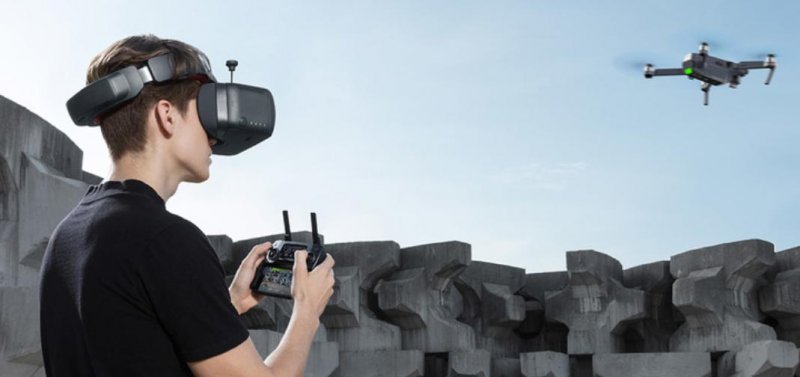DJI Goggles vs Racing Edition
DJI Goggles are a nifty piece of hardware that allows users to experience a futuristic flight experience. Just slip them on, and their high definition screens (one for each eye) will display a real-time, panoramic view of your drone’s flight. You can also use the headgear to steer certain drones by using head movements.
DJI has attempted to take things to the next level by releasing the Racing Edition. These goggles are marketed to people who want to race drones at high speed, and the company claims they have a number of improvements over the original goggles.
We will assess whether the Racing Edition is a significant improvement or just a lot of hype. We will also discuss the price of each pair and which one is the best value for money.
Compatibility
The original DJI Goggles are compatible with the Phantom 4 series, Inspire series, Mavic Pro, and Spark. The Racing Edition is compatible with these same drones as well. However, the big difference is that the Racing Edition makes use of DJI’s Ocusync Air system, which is a video transmission module and camera module.
This equipment can be mounted on any DJI or third-party drone, as well as any robot or RC. This gives massive flexibility, no matter what machines you want to incorporate with the goggles.
+1 for the Racing Edition
Comfort
The DJI Goggles Racing Edition has experienced some redesigning to make them more comfortable for users. The inside of the headband has been reinforced with leather to make it feel more padded. The facial pad has also been altered slightly to make it easier to wear.
+1 for the Racing Edition
Transmission Frequencies
The original DJI Goggles utilizes a 2.4GHz transmission band. This is a popular bandwidth and can get crowded. This can lead to interference when in certain areas and at certain times of the day. The Racing Edition also incorporates a 5.8GHz band, which can be used to avoid interference experienced on the 2.4GHz band.
+1 for the Racing Edition
Latency
The Racing Edition also has improved latency. For those unaware of what this is, we will quickly explain. Basically, latency refers to the delay between sending information and receiving it. This delay is determined by geographical distance as well as the communication equipment used. The lower the latency reading, the lower the delay.
The original DJI Goggles have a latency of 110 ms. The DJI Goggles Racing Edition can get down to 50 ms. If you’re going to be undertaking high-speed races, then you will want the lowest reading possible so that you can receive uninterrupted video footage.
+1 for the Racing Edition
Antennas
The Racing Edition has improved internal and external antennas. This has been proved to result in improved connectivity. These improvements also allow the goggles to receive both analog and digital signals.
+1 for the Racing Edition
SD Card Slot
The Racing Edition includes an SD card slot so you can record digital video. Unfortunately, the original goggles miss out on this handy feature.
+1 for the Racing Edition
Similarities
Both pairs of goggles have a range of similarities, which we will quickly touch on.
They both allow users to view a drone’s flight with twin 1080p HD screens.
The weight of each pair is pretty much the same. The original DJI Goggles weigh 495 grams while the Racing Edition weighs 502 grams. Seven grams makes no real difference.
The overall shape, feel, and design are also pretty similar. However, you will notice that the original DJI Goggles are white while the Racing Edition is black.
Both drones can be used to steer the Mavic Pro by using head movements. This can be done by activating the Head Tracking Flight mode on the DJI App.
Prices
A new pair of original DJI Goggles goes for $450 on Amazon. The Racing Edition costs around $550.
If you want the Ocusync Air system, so that you can incorporate the Racing Edition with a third-party drone or an unsupported DJI drone (the Phantom 3 range!), then you can purchase it for $150.
Remember, these are just approximate prices. To get the most accurate, up-to-date prices you should jump on Amazon yourself.
The original device has the lowest price.
+1 for the DJI Goggles
Results
The scores are shown below.
| DJI Goggles | DJI Goggles Racing Edition |
|---|---|
| 1 (Lowest price) | 6 (Compatibility, comfort, transmission frequencies, latency, antennas, SD card slot) |
It’s pretty one sided really. The Racing Edition has a variety of improvements without any setbacks. The only difference is the $100 price tag.
You can also see a side-by-side comparison below.
| Specs | DJI Goggles | DJI Goggles Racing Edition |
|---|---|---|
| Compatibility | Phantom 4 series, Inspire series, Mavic Pro, Spark | Any DJI drone and any third-party drone (by using the Ocusync Air System) |
| Transmission Frequencies | 2.4GHz | 2.4GHz and 5.8GHz |
| Signals | Digital | Digital and analog |
| Lowest Latency | 110 ms | 50 ms |
| SD Card Slot | No | Yes |
| Screen | 1080p HD | 1080p HD |
| Weight | 495 grams | 502 grams |
| Color | White | Black |
| Price | $450 | $550 |
Which One Should You Get?
Overall, the DJI Goggles Racing Edition has significant enhancements over the original. These goggles:
- Are compatible with any drone, aircraft, or vehicle (if you purchase the Ocusync Air System).
- Are more comfortable.
- Incorporate both 2.4GHz and 5.8GHz bands.
- Have improved latency.
- Have improved antennas.
- Have an SD card slot.
You just need to decide if it’s worth paying $100 more for these improvements. We figure for most people it is probably worth it. If you’re going to be spending a lot of time flying an expensive drone that you might as well fork over an extra $100 to get the best experience possible.
For another $150 you can purchase the Ocusync Air system which gives you the flexibility to incorporate the goggles with a range of other vehicles and aircraft. Therefore, if you have a Phantom 3 drone or a non-DJI drone, then you will want to purchase this device. The same goes if you have an RC plane or some other vehicle that you would like to incorporate with the goggles.



you’re wrong – the original goggles DO have a micro sd slot, right under the HDMI rubber cover…
That’s what I thought. I was about to get mine out to check.
Me Too.
The description says compatible with Mavic Pro. Are they compatible with Mavic 2 ??
Hi REN I hope I am wrong as only purchased race addition as you could record straight to the sd card on the race addition but not original goggles which had a slot but you can’t save video direct to the goggles you had to download from drone once completed flight. Think this is correct:-)
yes it is.. 🙂
yes it is compatible with mavic 2.. 🙂